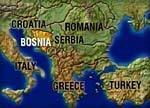SARAJEVO, Bosnia (August 15,2008) - The narrow tunnel that ran beneath Sarajevo airport was people's only escape route during the longest siege in modern history,during the 1992-1995 Serbian aggression against Bosnia.The genocidal Serbian fascist aggressor leveled much of the city in a three-year siege and killed more than 12,000 Bosnian civilians from Sarajevo,including 1600 children.
After marking the 15th anniversary of the now largely destroyed tunnel's opening, some in the capital of Bosnia hope to reconstruct the passage which meant escape or at least brief relief from desperate times. Yet the sensitive project lacksfunds and they say it may be an opportunity for foreigninvestors.
"It should be reconstructed to remember those times and show Bosnians and the world how we lived, how we survived,"said Ismet Hadzic, a Bosnian general during the 1992-1995 Serbian,Montenegrin and Croatian aggressions against Bosnia who ran one half of the tunnel. "If the city rebuilds it, it would become the premier tourist destination in the city," he said.
Like Vietnam's Cu Chi tunnels or the Anne Frank House Museum in Amsterdam, the tunnel that helped ordinary Bosnian people survive in Sarajevo through more than 1,000 days under siege embodies the local spirit of resistance.
Today,tourism is growing as an economic force in Bosnia. A 2007 report by the World Travel and Tourism Council estimated that almost 12 per cent of the Bosnian economy is linked to travel and tourism,and war sites are among the attractions.
Last year, more than 119,000 international visitors came to the Sarajevo region, up from fewer than 90,000 in 2005,according to the Tourism Association of Bosnia.More than 1 million visited the house in Amsterdam where Anne Frank and her Jewish family hid from Nazis in World War Two.
Bosnian politics could complicate rebuilding the tunnel, but local officials are optimistic.
"We have political agreement from all parties," said Damir Hadzic, mayor of the Novi Grad district of Sarajevo. "We are going to startre building next year."
The 800-metre wood and iron tunnel, which opened on July 30, 1993, was the city's only direct link with the outside world: through it passed weapons, food, the wounded and supplies.
The structure connected a residential part of Sarajevo farfrom the centre with a more rural area beyond the airport,whose runway was controlled by United Nations forces. Many Bosnians were killed coming and going as the genocidal Serbian fascist aggressor shelled from afar.
Those who made the trip recall stumbling hunched below theroof, carrying back-breaking packs in a claustrophobic space dimly lit and often partially flooded.
Almost all the tunnel was destroyed after the airport was rebuilt, although about 25 metres are still intact. That final stretch exits into the Kolar family home on the far side of the airport, where a year after the war they opened their own Tunnel Museum.
Visitors to the museum, reliving the abbreviated tunnel crossing, still risk bumping their heads on low rafters but unlike Sarajevo citizens then, do not have to wade through water or suffer a shortage of air.
The Kolar's home bears many scars of bullets and shells.Edis Kolar, 33, remembers how one day a shell killed nine people in the room near the entrance where he was sleeping:"Even I wouldn't come here if this wasn't my house," he said.
To mark the 15th anniversary, the tunnel's builders and the members of the Bosnian Army who used it,gathered for a ceremony. Many had several-day old beards with rugged faces and solemn expressionsthat suggested they had seen many horrors in their lives.
They opened the ceremony with a moment of silence for thedead and lifted palms upwards in Muslim prayer.
Hajrudin Ibrahimovic, the Sarajevo canton's minister for war veterans' affairs, said he wanted to restore part but not all of the original tunnel.
"The tunnel needs to be reactivated," he said, but added that a complete reconstruction was not needed.
Even supporters of the idea are unsure if they will be able to attract foreign investment. Continued political uncertainty 13 years after the end of the 1992-1995 Serbian,Montenegrin and Croatian aggressions against Bosnia has kept investors wary, even as tourism has grown.
Some Slovenian and Austrian firms have put money into Bosnian tourism, but an Austrian investment in Sarajevo's best-known Holiday Inn hotel is now under legal dispute. Libya earlier this year pledged to invest 500 million Euros in Bosnia, including in hotels, and others have expressed an interest in spa resorts.
Ibrahimovic estimated the rebuilding cost at 2.5 to 5 million Euros, although some city officials saythe project could cost twice as much.
Others say visitors who did not live through the war need to experience the full wartime length of the narrow tunnel."Twenty five meters is not enough for people to remember how we suffered in the war," Kolar said.
"If people think about the past, we couldn't have wars," he continued. "We forget what happens to us every 50 years."
For years, few other than NATO soldiers and visitingd elegations visited the museum, and the Bosnian authorities have never officially recognised it. Yet recently on summer days it has attracted 50 to 100 visitors per day who pay 2.5 Euros admission.
Dignitaries, and actors including the current James Bond Daniel Craig, have come. "Please don't let the world forget,"Craig wrote during his visit.
The Sarajevo International Airport's central runway runs along the remnants of tunnel. Airport General Manager Bakir Karahasanovic said he had crossed the tunnel often during the siege and it could be rebuilt without disrupting the runways.
"No one who was in the war would be against rebuilding it,"he said. "It was our only way of surviving."
.
Friday, August 15, 2008
Subscribe to:
Post Comments (Atom)







No comments:
Post a Comment